
Chapter 11. Recording and Retrieving Data
Data can be recorded to internal and external storage, in raw GCF format or in miniSEED format. Data can be browsed via the web interface or copied to external computers for further processing.
11.1 Preparing removable mass storage devices
When a new removable mass storage device is to be used with a acquisition module, it must first be formatted for use. The mass storage device can be formatted by any computer, but the acquisition module also has the capability of formatting the mass storage device itself. The acquisition module accepts mass storage devices formatted in either ext3 format (which is faster and more reliable, but can only be read under Linux systems) or VFAT format (slower and arguably less reliable, but can be read under all operating systems). To prepare the mass storage device on a PC, simply format it with a single partition containing either of the above file-systems; it can then be inserted directly into an acquisition module.
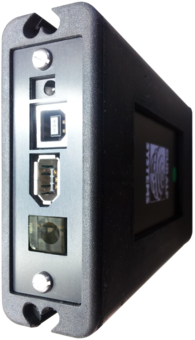 Note: When using removable mass storage devices from acquisition modules and CMG-DCMs with PCs, you may need to provide a power supply for the mass storage device.
Note: When using removable mass storage devices from acquisition modules and CMG-DCMs with PCs, you may need to provide a power supply for the mass storage device.
When using a six-circuit (powered) IEEE1394 FireWire interface, the mass storage device can draw its power from the host PC. When connected to a four-circuit (un-powered) FireWire interface, such as Sony i.Link, external power needs to be applied as described below. Power also needs to be supplied when using the USB interface.
A power supply of between 4.5V and 30V DC should be connected to the 2.1 mm barrel connector (uppermost in the picture). The central pin of the connector should be connected to the positive supply line.
IMPORTANT: Do not connect anything to the larger barrel connector, if fitted. This was used for the heater and temperature sensor on units manufactured before 2013. On later units, it is replaced with a clear plastic window which allows easy viewing of the internal diagnostic LEDs.
To prepare a mass storage device using the web interface select:
Tools → Removable disk → Format disk
After a delay, while the mass storage device powers up, the following screen will appear:
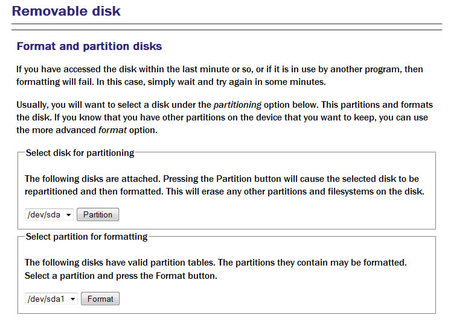
The drop-down menus for device selection use the Linux device naming convention, where /dev/sda is the first device, /dev/sdb is the second and so on. Individual partitions on devices are identified by an appended number, so /dev/sda1 is the first partition on the first device and /dev/sdb3 is the third partition on the second device.
The  button causes the selected device to be repartitioned with a single partition which is then reformatted. If you are using a device with existing partitions that you wish to preserve, you should use the
button causes the selected device to be repartitioned with a single partition which is then reformatted. If you are using a device with existing partitions that you wish to preserve, you should use the  button instead.
button instead.
Successful completion of the format is signalled by a short, on-screen message. The mass storage device is then ready for use.
Mass storage devices can also be formatted from the command line with the command
eam999 ~ # Pt-storage --format
11.2 Recording data
All data recording is performed by the gdi-record service. Data are recorded first to a buffer held in flash memory. When the buffer utilisation exceeds a configurable percentage, data are flushed to the hard drive. In low power applications, the hard drive will normally be powered down and, so, must be powered up and mounted before use. This is handled by the Pt-storage service. The disk is dismounted and powered down once the flush is complete. An option exists to provide permanent power to the disk.
Older removable hard drives were equipped with a temperature sensor and heating element. In low temperature applications, the drive would be automatically warmed to a safe operating temperature before power was applied. Modern GSL removable hard drives do not require pre-heating.
The options that control this process are all on one page but, given its size, it is shown here in sections.
To configure data storage using the web interface, select
Configuration → Storage and recording
or
Configuration → All options → Storage and recording
To configure recording from the command line, start gconfig and select “Storage and recording” from the top level menu.
11.2.1 Configurable parameters
The configuration screen for recording data has five tabbed pages: Storage device, MiniSEED, GCF, Non-seismic data, NFS and Advanced. No expert mode screens are required.
Selecting
Configuration → Storage and recording
displays the following screen:
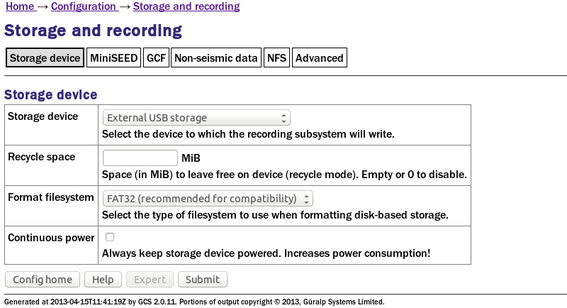
11.2.1.1 Storage device
The “Storage device” tab has the following fields:
Storage device: This drop-down menu lets you choose from the storage options available on your system. The options may include one or more of:
“Removable USB disk in internal tray” - this is the default setting for CMG_EAMs and CMG-DCMs. Data are written to the removable USB/FireWire disk and can be read via the web interface, the command line or by removing the mass storage device and attaching it to an external USB or FireWire host, such as a PC or laptop.;
“External USB drive on mil-spec connector” - data will be stored on external media, which should be attached to the USB connector. The Pt-storage daemon handles the required operations for mounting and un-mounting the file-system;
“Internal USB storage” - for cylindrical digitisers only, data can be stored on internal USB-accessible flash memory. It can be retrieved by a USB host (such as a laptop) connected via the GPIO connector. See section 15.1.3.1 for more details;
“Ring buffer on flash module” - some systems are equipped with an external flash module to extend the storage capacity beyond that available on the normal file-system. Data written here are accessible via the web interface or, from the command line, under the path /media/flash_module;
“Record files under /var/spool/recdata” - this is the only option on CMG-NAMs and CMG-NAM64s and it is not available on other platforms. Data are written directly to the internal hard drive and are accessible via the web interface or, from the command line, under the path /var/spool/recdata.
“Remote NFS mount” - this option causes data to be written to a remote, network-accessible storage device that uses NFS as the underlying protocol, such as NAS units. See section 11.2.1.5 for configuration details.
Recycle space: If this check-box is set to zero, gdi-record will write to the storage device until it is full and then stop writing. The module will check periodically for free space and start writing again when it can. This prioritises the earliest data at the expense of the most recent data.
If the “recycle space” field is set to any other numerical value, it is interpreted as the amount of free space, in MebiBytes, to leave on the disk. When this value is approached, older data are deleted to make space for the current data. This prioritises the most recent data at the expense of the earliest data.
Format filesystem: This drop-down menu allows you to select the format used when the storage device is reformatted. The current choices are FAT32 and ext4. The ext4 filesystem is more robust and should be used where possible but it is not currently supported by Microsoft windows. If you need to read the storage device under windows (for example, by using the GPIO/USB cable), then you should choose FAT32.
Continuous power: In order to reduce power consumption, gdi-record does not write continuously to the hard drive. Data are buffered in flash memory and, at a configurable interval, these data are checked to see which complete files can be written to a mass storage device. The storage device is powered down when not in use. If power is not a consideration, certain options (such as retrieving data to remote systems using scp) are easier if the power to the storage device is left on continuously. Tick this check-box to enable continuous power to the storage device.
11.2.1.2 MiniSEED
For some applications, it is more convenient to store the data directly in mini-SEED format. The second tab of the “Storage and recording” page controls options related to recording in this format. If recording in mini-SEED format is enabled, a GDI to Mini-SEED compressor (converter) is started automatically. See section 12.2 for more details.
Selecting the “MiniSEED” tab displays the following screen:
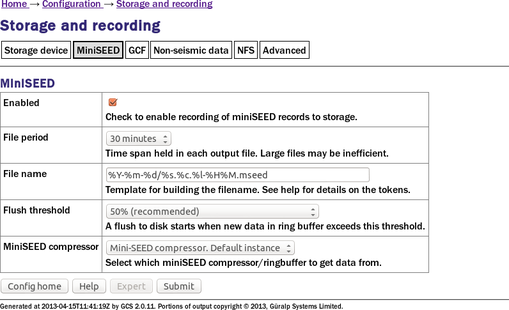
Enabled: MiniSEED recording will be enabled if this check-box is ticked and disabled otherwise.
File period: This drop-down menu offers a choice of file periods: the options are 15 or 30 minutes and 1, 2, 3, 4, 6, 12 or 24 hours. If set, for example, to 15 minutes, four files will be generated each hour whereas, if set to 24 hours, only one file will be generated per day. The files may contain a single component or multiple components: see the next field description for details. The default file period is 30 minutes.
File name: The contents of this field determine how the data files are named. Tokens within the field are replaced by parameters derived from the data while all other characters are coped verbatim into the resulting file-names. It is possible to organise files into hierarchical directories by using forward-slash characters ('/') in this field. Please see section 11.2.2 for details of the tokens that can be used.
Note that if this field contains any token that identifies a stream, individual files will be created for each stream. If no such token is present, multiple streams will be recorded into each file.
Flush threshold: This drop-down menu allows control over the percentage utilisation of the miniSEED ring-buffer which triggers a flush to the mass storage device. The default is 50% but you can also choose 10%, 25% or 75%.
MiniSEED compressor: This drop-down menu allows the operator to select which instance of gdi2miniseed is used as the data source. The menu will offer all configured instances.
11.2.1.3 GCF
GCF is the native recording format of Platinum firmware. It can be read directly by Scream and many software packages are available (from the GSL web-site) for converting it into other formats.
Selecting the “GCF” tab displays the following screen:
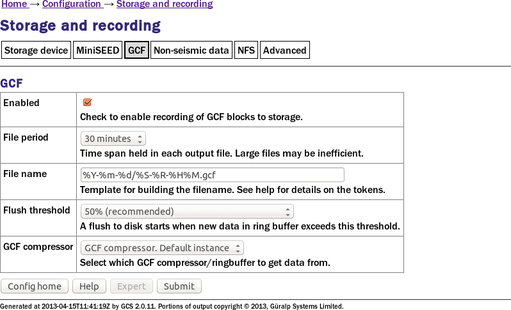
Enabled: GCF recording will be enabled if this check-box is ticked and disabled otherwise.
File period: This drop-down menu offers a choice of file periods: the options are 15 or 30 minutes and 1, 2, 3, 4, 6, 12 or 24 hours. If set, for example, to 15 minutes, four files will be generated each hour whereas, if set to 24 hours, only one file will be generated per day. The files may contain a single component or multiple components: see the next field description for details. The default file period is 30 minutes.
File name: The contents of this field determine how the data files are named. Tokens within the field are replaced by parameters derived from the data while all other characters are coped verbatim into the resulting file-names. It is possible to organise files into hierarchical directories by using forward-slash characters ('/') in this field. Please see section 11.2.2 for details of the tokens that can be used.
Note that if this field contains any token that identifies a stream, individual files will be created for each stream. If no such token is present, multiple streams will be recorded into each file.
Flush threshold: This drop-down menu allows control over the percentage utilisation of the GCF ring-buffer which triggers a flush to the mass storage device. The default is 50% but you can also choose 10%, 25% or 75%.
GCF compressor: This drop-down menu allows the operator to select which instance of gdi2gcf is used as the data source. The menu will offer all configured instances.
11.2.1.4 Non-seismic data
Selecting the “Non-seismic data” tab displays the following screen:
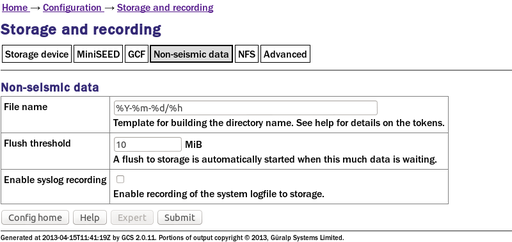
This facility can be used to copy data files from your own applications and, optionally, the system log files to the mass storage device, simplifying transfer of these data from the unit to external systems.
Files to be copied should be created in the directory /var/spool/to-rdisk.
The following options are available:
File name: When building the directory in to which files are copied, any tokens in the template string are replaced with strings based on the current date/time. The following tokens are supported:
%% | a literal percentage sign |
%h | system hostname |
%Y | 4-digit year number |
%m | 2-digit month number (01-12) |
%d | 2-digit day of month (01-31) |
%j | 3-digit ordinal day/day of year (001-366) |
%H | 2-digit hour (00-23) |
%M | 2-digit minute (00-59) |
%I | 4-digit ISO year number (for use with ISO week) |
%W | 2-digit ISO week number (01-52) |
%w | 1-digit ISO day of week (1/Monday-7/Sunday) |
Forward-slashes ('/') will cause subdirectories to be created. If using recycle mode, be sure to start the file-name template with the date in either year-month-day, year-ordinal or year-week-weekday format so that the sorting algorithm can identify the oldest files correctly.
Flush threshold: Files from /var/spool/to-rdisk are copied to the mass storage device when their total size exceeds the threshold size defined (in Mebibytes) in this field.
Enable syslog recording: If this checkbox is ticked, the system log (/var/log/messages) is also copied to the mass storage device. This option consumes very little space and can be a significant help when debugging any problems.
11.2.1.5 NFS
Platinum systems can write to external, network-accessible NFS storage systems, such as NAS systems. This option is primarily intended for use with CMG-NAMs and CMG-NAM64s in data-centre applications. GSL can supply suitable NAS systems for this purpose.
To use external NFS storage, select “Remote NFS mount” in the “Storage device” drop-down menu of the “Storage device” tab (see section 11.2.1.1) and complete the fields in the “NFS” tab as described below.
Selecting the NFS tab causes the following screen to be displayed:
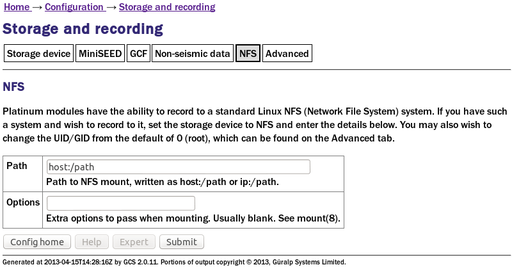
Path: Use this field to specify the NFS host and the path on that host to use for storing data. For example, if the data are to be stored in a directory called GCF-data on a NAS host called nas0.datacentre.example.com, enter
nas0.datacentre.example.com:/GCF-data
in this field.
Options: The external storage provided by the NFS server will be prepared for access using the standard Linux mount command (see http://linux.die.net/man/8/mount for details) invoked without non-mandatory options. If additional options are required (for example, to specify a hard mount rather than a soft mount), they can be entered here.
11.2.1.6 Advanced
The “Advanced” tab of the “Storage and recording” screen contains a number of specialised options. Selecting the tab displays the following screen:
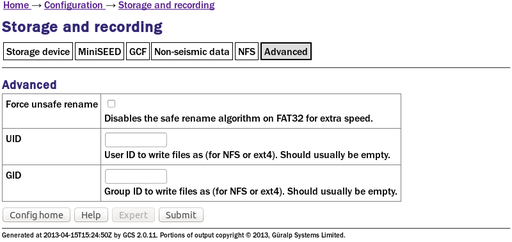
Force unsafe rename: The recording system takes considerable care to avoid data loss in the event of power disconnection or storage device removal. When the storage device is formatted as a FAT32 volume, part of this care involves a “safe rename” routine, which takes a little time to complete. When the power budget is particularly tight, this extra time costs extra power as the storage device needs to be powered up for longer. Ticking this check-box disables the safe rename routine, reducing the amount of time for which the storage device needs to be powered at the cost of increased vulnerability to power outages or unexpected storage device disconnection.
UID and GID: When recording to an NFS or ext4 volume, files are normally written as user “root” and group “root”. If this is undesirable, another user ID and/or group ID can be specified using these two fields.
11.2.2 File name escape sequences
Escape sequences (tokens) are used in the “File name” fields in the MiniSEED and GCF recording configuration pages. The escape sequences all begin with a percent character ('%') and are used to insert variable data such as the date or stream name into the file or directory name; each escape sequence is replaced with the relevant value. Any non-escape sequence characters are copied verbatim into the name, as are unrecognised escape sequences. All numbers are decimal and will have leading zeroes added to fill the required number of digits, where appropriate.
The available escape sequences are listed below. Items marked † only have values in GCF context and will be replaced by the relevant number of spaces if used with miniSEED. Items marked ‡ only have values in miniSEED context:
%d | 2 digit day of month (01-31) |
%H | 2 digit hour in 24 hour clock (00-23) |
%j | 3 digit Julian day |
%m | 2 digit month (01-12) |
%M | 2 digit minute (00-59) |
%y | 2 digit year i.e. without century digits (00-99) |
%Y | 4 digit year |
%S | GCF System ID † |
%C | GCF Stream ID † |
%s | 5 char SEED station identifier (spaces are removed from all SEED Ids) ‡ |
%c | 3 char SEED channel identifier ‡ |
%n | 2 char SEED network identifier ‡ |
%l | 2 char SEED location identifier ‡ |
%b | block length |
%f | bits/sample or compression format |
%p | samples/second |
%% | % (a literal percent sign) |
If the format string ends in a .extension (without any escape sequences in the extension) then this extension will be noted and used in some other locations – e.g. for the top level date directory.
The default format strings are:
GCF Directory format: %Y%j-gcfraw
GCF File format: %Y%jT%H%MZ.gcf
miniSEED Directory format: %Y%j-mseed
miniSEED File format: %Y%j-%H%M-%s-%c-%n-%l.mseed
Slashes “/” will cause subdirectories to be created. Using them as date separators will have unintended and, usually, undesirable consequences.
11.2.2.1 Some examples
The GCF default, %Y%jT%H%MZ.gcf, includes the data and time but no stream identifiers, resulting in a single file containing all streams per recording period. This will produce file-names like:
2008315T1445Z.gcf
If you are recording at two different sample rates, including a %p will cause all streams at the same rate to be grouped into one file per rate per recording period. Using %Y%jT%H%MZ_%p.gcf might produce files like:
2008315T1445Z_200.gcf and
2008315T1445Z_50.gcf
If you need one file per stream, include the %C sequence. Using the format %Y%jT%H%MZ_%C.gcf would produce files like:
2008315T1445Z_406N2.gcf
2008315T1445Z_406E2.gcf and
2008315T1445Z_406Z2.gcf
Adding a %S would add the system ID, so %Y%jT%H%MZ_%S_%C.gcf would produce files like:
2008315T1445Z_EKA_406N2.gcf
The miniSEED default %Y%jT%H%MZ-%s-%c-%n-%l.mseed includes the date, the time and the complete SCNL identification. The date format matches that used by the GCF recorder. This will produce file-names like:
2008315T1442Z-TEST1-BHE-NN-LL.mseed
To combine all the channels from a given station simply omit the channel marker from the file name format string:
%Y%jT%H%MZ-%s--%n-%l.mseed
It is recommended that the “--” is left in place to highlight the omitted channel id. This will produce file-names like:
2008315T1442Z-TEST1--NN-LL.mseed
If you specifically want to include a marker to identify that it contains all channels, the use of a lower case string will differentiate it from a regular channel name, which is always presented in upper case.
%Y%jT%H%MZ-%s-all-%n-%l.mseed
yields file-names like:
2008315T1442Z-TEST1-all-NN-LL.mseed
If you prefer human readable dates, rather than using the Julian date
%Y_%m_%d-%H:%M-%s-%c-%n-%l.mseed
yields file-names like:
2008_08_14-14:42-TEST1-BHE-NN-LL.mseed
Note: Using / as a date separator will split the data into sub-directories, which may not be the desired result.
It is often required to separate the data into sub directories by network and station prefix. In this case, it is recommended that the network and station id are still included in the file-name so that the contents of the file are still recognisable even if it is moved to a different location.
%n_%s/%Y%jT%H%MZ-%s-%c-%n-%l.mseed
will store the data like this:
NN_TEST1
2008315T1442Z-TEST1-BHE-NN-LL.mseed
2008315T1452Z-TEST1-BHE-NN-LL.mseed
2008315T1502Z-TEST1-BHE-NN-LL.mseed
...
NN_TEST2
2008315T1442Z-TEST2-BHE-NN-LL.mseed
2008315T1452Z-TEST2-BHE-NN-LL.mseed
2008315T1502Z-TEST2-BHE-NN-LL.mseed ...
11.3 Retrieving data
Data are recorded first to buffers held in flash memory. There are separate buffers for GCF and miniSEED data and their sizes are defined in the configuration pages for their respective compressors (See section 12.1.1 for the GCF compressor and section 12.2.1 for the miniSEED compressor). When the buffer utilisation exceeds a configurable percentage (as specified in the relevant tabs of the Configuration → Storage and recording page), a process is triggered to flush the data to the hard drive. In low power applications, the hard drive will normally be powered down and, so, must be powered up and mounted before use. It is then dismounted and powered down once the flush is complete.
If you wish to work with data on the removable drive, it must first be powered up. This is done automatically when using the web interface but must be done manually when working from the command line. If you wish to work with recent data, a manual flush should first be performed in order to move the data from the buffer memory to the drive.
Facilities exist to aid automation of data downloads. See section 11.3.1.3 for details.
11.3.1 Retrieving data from the removable drive
Note: Older removable hard-drives had internal heaters and temperature sensors. It can take several seconds to pre-heat and power up one of these drives. Be prepared for short delays when using some of the following commands with these drives.
Data from the removable drive can be retrieved using the web interface, using network file transfer tools or over a serial port.
The web interface is most convenient if you only want to download one or two files. It is not suitable for large numbers of files or for automated downloads.
Using the serial interface is slow and also not suitable for large numbers of files or for automated downloads.
The use of network transfer tools, such as scp, sftp or rsync, is recommended in most cases. If large numbers of files are to be downloaded or if the process is to be automated, a special user can be created to simplify the process. When this user logs in over ssh (as used by rsync), scp or sftp, the storage is mounted automatically and dismounted when the user logs out again. See section 11.3.1.3 for details.
11.3.1.1 Downloading over a network, using the web interface
To retrieve data from the removable drive using the web interface, select:
Tools → Storage and recording
The following screen is displayed:
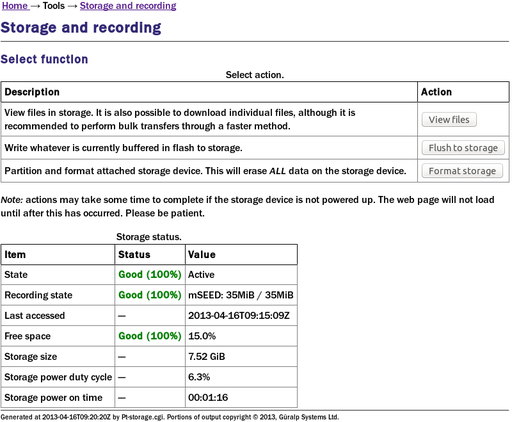
The top of the screen offers various action buttons while the bottom half displays some status information.
In the example given above, one can see that the storage is currently mounted and in use (“Active”) and that a flush of MiniSEED data is almost complete (“35MiB/35MiB”). The size and utilisation of the device is also given.
The “storage power duty cycle” shown is the ratio of the total time during which the storage has been powered up to the system uptime (the time since the last boot) expressed as a percentage. In power-critical applications, this provides useful feedback when tuning the ring-buffer sizes and fill thresholds (see section 11.2.1 for details of these parameters).
If you wish to retrieve the most recent data, first click the  button to copy all pending data from the buffer memory to the hard drive. A progress screen will display messages as the various stages of the process complete.
button to copy all pending data from the buffer memory to the hard drive. A progress screen will display messages as the various stages of the process complete.
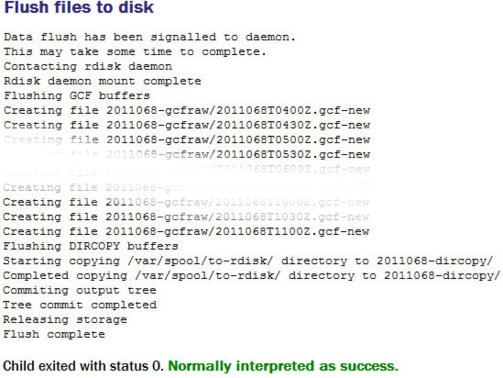
Once the flush process has completed, as shown above, return to the main disk menu by clicking on “Removable disk” on the “Tools” menu.
You can now click the  button. This will power up any connected mass storage devices and, after a short delay, present a list of attached devices and their details (filesystem, free space, etc):
button. This will power up any connected mass storage devices and, after a short delay, present a list of attached devices and their details (filesystem, free space, etc):

Clicking on any of the  buttons takes you to the “Removable disk file index” screen, which displays folders and files within the selected filesystem. Subdirectories (folders) have a
buttons takes you to the “Removable disk file index” screen, which displays folders and files within the selected filesystem. Subdirectories (folders) have a  button next to them and files have a
button next to them and files have a  button.
button.
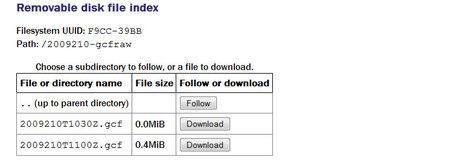
If the displayed directory contained subdirectories, you could continue to navigate down them using the  buttons. When files are present, as in the above screen-shot, they each have an associated
buttons. When files are present, as in the above screen-shot, they each have an associated  button which invokes your web browser's standard download facility to copy the data to your computer.
button which invokes your web browser's standard download facility to copy the data to your computer.
11.3.1.2 Downloading over a network, using the command line
If very recent data are required, start by flushing the buffers with the command:
eam999 ~ # gdi-record --flush
Before data can be retrieved from the removable drive, it must first be brought to operating temperature (for heated drives), powered up and the relevant file-systems mounted. A utility, Pt-storage, is provided to accomplish this.
When invoked without arguments, Pt-storage displays a menu:
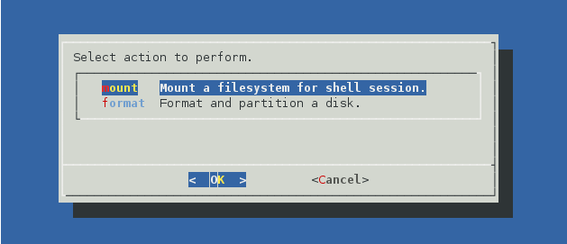
The “mount” option, which can be selected with the  key, displays a menu of available file-systems on removable media. When you choose your desired file-system, it is mounted under /media and you will be told the exact mount point and then presented with a command prompt. This is a sub-shell: the file-system will remain mounted and the mass storage device will remain powered up until you exit the shell (with the exit command or by keying
key, displays a menu of available file-systems on removable media. When you choose your desired file-system, it is mounted under /media and you will be told the exact mount point and then presented with a command prompt. This is a sub-shell: the file-system will remain mounted and the mass storage device will remain powered up until you exit the shell (with the exit command or by keying  +
+  ).
).
The “format” option, which can be selected with the  key, prepares a drive for use, as described in section 11.1.
key, prepares a drive for use, as described in section 11.1.
When using shell scripts, all of these menu functions can be accessed by passing the function name as an argument to Pt-storage. For example:
eam999 ~ # Pt-storage --mount
performs the same function as selecting ”mount” from the Pt-storage menu.
Note: Older removable hard-drives had internal heaters and temperature sensors. It can take several seconds to pre-heat and power up one of these drives. Be prepared for short delays when using some of the following commands with these drives.
Once the mass storage device is powered up and the relevant file-system mounted, the recorded files can be browsed with standard Linux shell commands such as cd and ls. They can be copied to a remote PC using the network or over the serial port (as described in section 11.3.1.4).
To copy files over the network, the use of scp or rsync is recommended. The scp program is most convenient to use and can copy single files or recursively copy directories. The rsync program is more complicated but is ideal when a remote copy of the data is to be updated regularly, since it minimises the traffic over the network by only copying new or changed files. The same rsync syntax can be reused regardless of changing filenames.
For Linux users, scp is installed by default or available as an optional package in most distributions. Consult your operating system documentation for more details. For Windows users, the WinSCP package is recommended: this has the additional benefit of providing a graphical, explorer-like interface for browsing files on the acquisition module. WinSCP can be downloaded for free from http://winscp.net.
The screen-grab below shows a complete session recorded from a Linux PC. The operator connects to a acquisition module, powers up the mass storage devices, downloads all recorded files, powers down the mass storage devices and then disconnects.
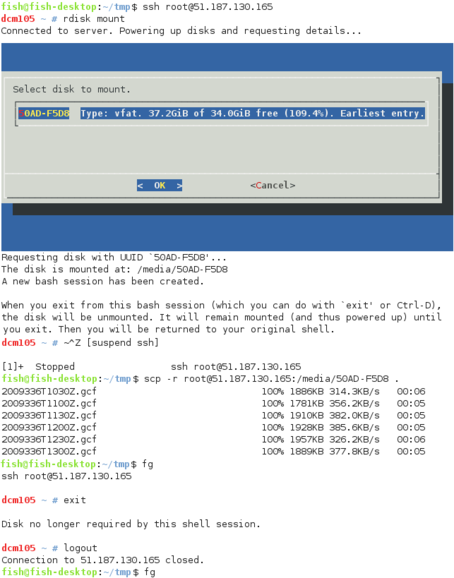
Note the use of ssh's tilde ('~') escape followed by  +
+  to suspend the ssh session and return to the calling PC, in order to run the scp command with the mass storage device still mounted. The fg command (foreground) returns control to the ssh session.
to suspend the ssh session and return to the calling PC, in order to run the scp command with the mass storage device still mounted. The fg command (foreground) returns control to the ssh session.
Windows users should follow the same procedure to log in, power up and mount the file system. At this point, rather than suspending the ssh shell, they can connect with WinSCP and navigate to the /media directory. The recorded files will then be displayed and can be dragged and dropped to appropriate locations on the PC:
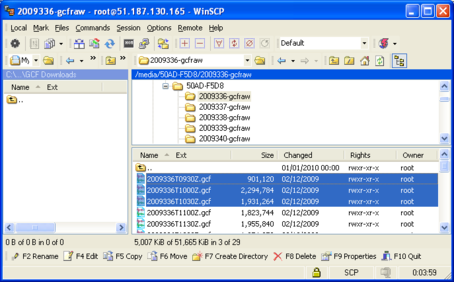
When the transfer is complete, return to the ssh session and power down the mass storage devices (with the exit command or by keying  +
+  ).
).
Using rsync is very similar: simply replace the invocation of scp in the above instructions with an appropriate rsync command.
For Linux users, the simplest usage is
me@mypc:~/dl $ rsync -avz root@51.187.130.165:/media/*/
This will copy all files from all removable drives to the current directory on the invoking computer. Only the differences are transferred, making this particularly efficient when used regularly. For more advanced usage, please see the rsync manual, available on-line at http://man-wiki.net/index.php/1:rsync-2006.11.06
Windows users can download a free port of rsync using the cygwin library (see http://www.cygwin.com/ for more information) or use one of several free, graphical interfaces, such as grsync, available from http://sourceforge.net/projects/grsync-win/files
The following screen-shot shows grsync about to download all data from a removable drive. Note the password prompt appearing in the separate console window.
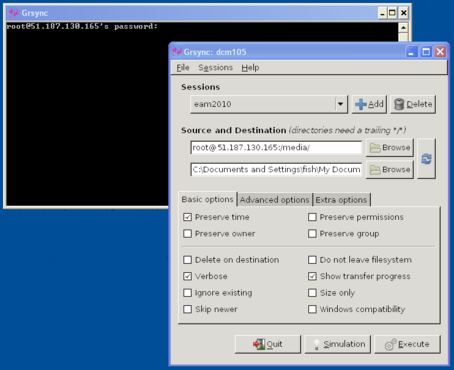
11.3.1.3 Automating network downloads
If data are to be repeatedly downloaded from a Platinum system, it is possible to automate the mounting and dismounting of the storage device, which considerably simplifies the operation. This is accomplished by means of a special user identity: the special user is configured so that the storage device is mounted automatically when the user logs in and dismounted automatically when the user logs out. Network file transfer protocols such as scp, sftp and rsync all involve a hidden login so, as long as they authenticate as the special user, they can be invoked at any time without the need for a command-line session to handle device operations.
To create the special user, run the command Pt-storage-adduser followed by the desired username – this command will prompt interactively for a password for the new user. The password will not be echoed to the screen.
Note: If the system is to be connected permanently to the Internet, it is necessary to choose a strong password. Since the password will almost certainly be programmed into the client file transfer software, there is no requirement for it to be memorable. GSL recommend the use of password-generation software for this purpose. There are a number of good, free password-generating applications and web-sites available on the Internet.
A typical invocation looks like this:
eam999# Pt-storage-adduser dskusr
New password:
Repeat password:
Password changed
New user 'dskusr' added and ready
eam999#
The chosen username, “dskusr” in this example, can be anything you wish but must consist of lower-case letters and digits only.
The new user can now be used with file transfer commands. For example, from a Linux box, you could enter commands like
me@mypc:~/dl $ ssh dskusr@eam999 gdi-record --flush
me@mypc:~/dl $ rsync -avz dskusr@eam999:/media/*/
This will flush outstanding data from the ring-buffers and then synchronise all files from the mass storage device to the current directory on the invoking computer.
It is also possible to eliminate the password prompt. To do this:
Run the following commands on the Platinum system:
mkdir -m 700 ~dskusr/.ssh > ~dskusr/.ssh/authorized_keys
chmod 600 ~dskusr/.ssh/authorized_keysreplacing dskusr with the name of your own special user.
create an ssh key pair on the client PC, using the ssh-keygen command on Linux or the PuTTYgen application on windows.
Copy the newly created public key into the authorized_keys file.
The new user should now be able to invoke ssh, scp, sftp or rsync without being prompted for a password.
Once you are happy that password-less logins are working, you can remove the password for the new user by editing /etc/shadow on the Platinum system and replacing the encrypted password – the part of the line between the first and second colons – with an exclamation mark ('!').
11.3.1.4 Downloading over a serial port, using the command line
In situations where it is not convenient to use the network interface, files can be downloaded from the removable mass storage device using one of three file-transfer protocols, X-modem, Y-modem or Z-modem. None of these protocols were ever rigidly standardised so, if you are not using one of the terminal emulators discussed in this section, you may need to experiment a little: this is reflected in the huge range of optional arguments that the transfer program accepts.
The X-modem transmitter is invoked as sx, the Y-modem transmitter as sy and the Z-modem transmitter as sz. They are, in fact, all implemented by the same program so the detailed help message (displayed with the --help option) describes options relevant to all three protocols.
Linux users are advised to use the minicom terminal emulator. This includes X-modem support and its use is described below. For Windows users, we describe the use of HyperTerminal, which is supplied with many Windows systems.
For minicom users, the X-modem protocol should first be configured: start minicom and type  +
+  (minicom's escape sequence) and then
(minicom's escape sequence) and then  to display the options menu:
to display the options menu:
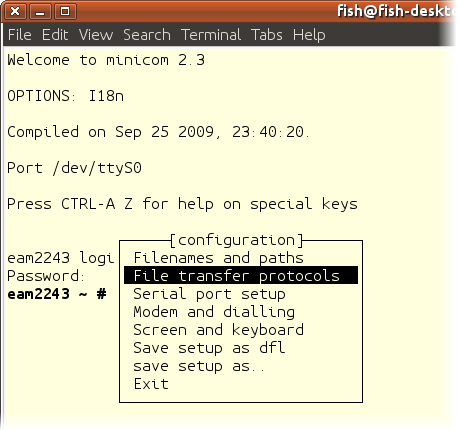
Select “File transfer protocols” and ensure that the command used for X-modem transfers is set to /usr/bin/sx -vv
Before attempting to download files, you should flush the recording buffers and mount the mass storage device. The buffers can be flushed with the command:
eam2010 ~ # gdi-record --flush
and the mass storage device can be mounted and held in a powered-up state by use of the Pt-storage facility, as described in section 11.3.1.2.
Once the mass storage device is mounted, you can proceed to download files by entering commands like
eam2010 ~ # sx path-to-file
and then immediately typing  +
+  followed by
followed by  to activate minicom's receive file function. Select “xmodem” from the resulting menu and then enter a name for the downloaded file. The transfer should start immediately with a progress indicator displayed:
to activate minicom's receive file function. Select “xmodem” from the resulting menu and then enter a name for the downloaded file. The transfer should start immediately with a progress indicator displayed:
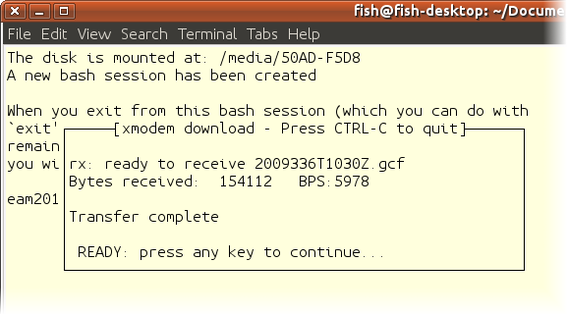
HyperTerminal users should flush the buffers, mount the mass storage device, type the command
eam2010 ~ # sx path-to-file
and then immediately select “Receive File...” from the “Transfer” menu. A dialogue asking for the destination directory name is followed by another asking for the destination file name:
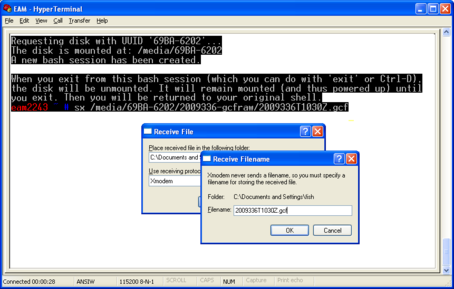
When you click the “OK” button, a progress indicator appears:
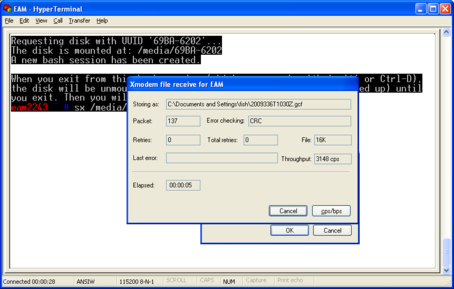
You will be returned to the prompt when the transfer is complete.
11.3.2 Reading the removable drive on other computers
The mass storage device may be disconnected from the system at any time without risk of data loss. In practice, users will normally manually flush the memory contents to mass storage device (using either the gdi-record --flush command or the  button on the “Removable disk” page of the web interface) and allow that process to complete before removing the drive.
button on the “Removable disk” page of the web interface) and allow that process to complete before removing the drive.
The drive can then be connected to any computer that supports external USB or FireWire storage devices. In some circumstances, you may need to provide a power connection to the drive: see section 11.1 for more details.
The mass storage device may have been formatted as either a VFAT or ext3 volume. Windows computers cannot read ext3 volumes without additional software such as “Explore2fs” or “DiskInternals Linux Reader”. See http://www.howtoforge.com/access-linux-partitions-from-windows for more details about these two packages.
11.3.3 Accessing internal storage directly
Certain systems, such as integrated instruments and cylindrical digitisers are fitted with an internal Flash memory device which is accessible via USB. It can be written to by selecting “Internal USB storage” from the “Recording destination” drop-down menu on the “Disk recording” page (see section 11.2).
When a USB host, such as a laptop or PC, is connected to the GPIO port (the pin-out of which is given in section 16.5.6) internal circuitry detects the USB power and automatically connects the Flash memory directly to the GPIO socket, causing it to behave identically to a standard USB memory stick. This method can be used even if no power is supplied to the EAM.
When no power is detected at the GPIO port, the Flash memory is available to the system as if it were a standard removable mass storage device. All of the mass storage device recording options described above (in section 11.2) will apply to this device, as will the other data access options described in section 11.3.1.